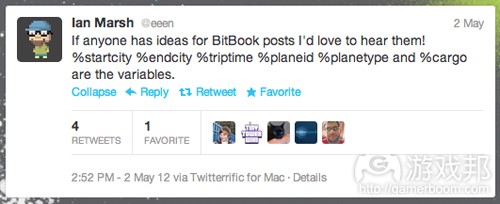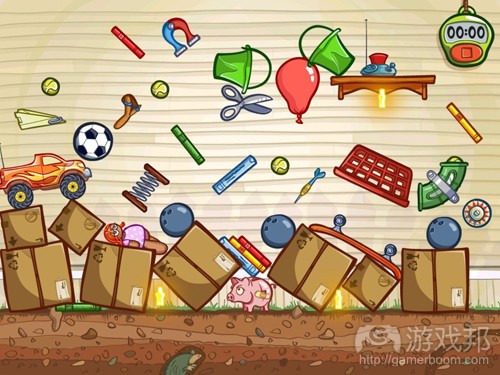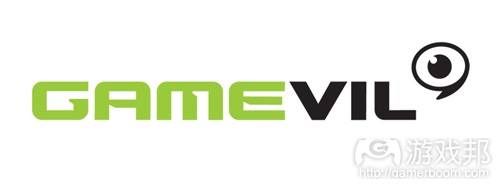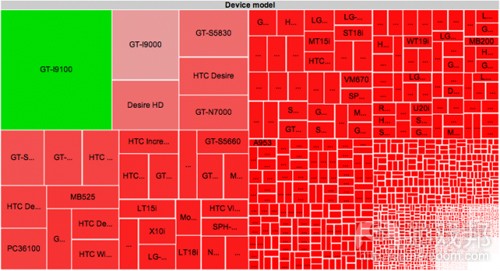每日观察:关注平板电脑游戏付费玩家平均消费情况(5.16)
1)据gamesindustry报道,Magid Associates最新调查数据显示,50%的活跃游戏玩家每周至少玩一次控制器游戏,44%每周至少玩一次手机游戏,37%玩社交游戏,27%玩掌上设备游戏。
平板电脑游戏玩家2011年平均下载20多款应用程序,其中有23%用户在游戏中付费购买虚拟商品,每名付费用户平均消费额达62美元。
智能手机玩家去年平均下载10多款应用程序,其中有14%用户为虚拟商品付费,每名付费用户平均消费额为25美元。
2)英国折扣网站MyVoucherCodes.co.uk最近调查结果指出,54%的英国受访者每周玩《Draw Something》这款绘图游戏不足一次,现在仅有13%用户仍然每天都玩这款游戏。
有三分之二受访者称自己之前曾因玩这款游戏而无心工作,平均每人在该游戏上投入时间达30分钟。有47%受访者称这款游戏已经没有新鲜感,还有31%称自己已经厌倦该游戏。
MyVoucherCodes.co.uk网站总裁Mark Pearson表示,许多人之前每天都玩这款游戏,现在发展成为5周内都不会玩几次,这种情况表明用户停止玩这款游戏后便很容易将其搁置一旁;如果用户的好友不再玩这款游戏,用户与其他随机用户玩游戏就不那么有趣了。
3)据insidemobileapps报道,《Tiny Tower》开发商Nimblebit最近通过Twitter发贴,针对新款游戏《Pocket Planes》(游戏邦注:该游戏预计于6月份发布)的用户界面元素优化问题征求玩家意见。
该工作室联合创始人Ian Marsh发布了两张游戏菜单,询问玩家是否认为更小一点的按钮看着更舒服(如下图):
这并非Nimblebit首次就游戏设计问题寻求玩家反馈意见,在本月初Marsh就已针对Pocket Planes BitBook发贴功能询问玩家看法,据称此举得到了Twitter粉丝的积极回应,约有20或30个粉丝创意被添加到这款游戏中。
这种让用户参与游戏设计的做法让Nimblebit获益匪浅,目前该公司旗下的《口袋青蛙》和《Tiny Tower》所创收益已超过开发成本的100倍以上;该公司在之前的采访中曾透露《Tiny Tower》付费转化率达到了5%左右,平均每名付费用户消费额为10美元。
4)《凯西的精巧设计》开发者Noel Llopis最近通过博客解释了他与另一名开发者Miguel A. Friginal将该游戏IP出售给Rovio的原因,据其所称,他们此举并非为财,而是因为他们认为这款游戏找到了“很好的归宿”。
在他们看来,Rovio是一个出色的团队,《愤怒的小鸟》绝非侥幸成功之作;他们今后不会再介入《凯西的精巧设计》的开发过程,而是转向其他新项目。
《凯西的精巧设计》将以《Amazing Alex》的名称由Rovio重新发行,预计于7月份登陆iOS和Android平台,原版游戏现已在App Store撤架。
5)韩国手机游戏公司Gamevil第一季度财报(截止3月份)显示,公司在该时期手机游戏下载量达1.2亿次,销售额达166亿韩元(1440万美元),比去年同期增长160%;利润为52亿韩元(450万美元),同比增长105%。
有91%销售额来自IAP模式,智能手机游戏销售额占比92%,海外收益增长437%;Gamevil计划在本财年(截止12月份)推出40多款游戏,有16款游戏将于4-7月期间发布(其中5款出自内部开发团队之手,有11款为外部开发游戏)。
6) OpenSignalMaps团队最近通过下载其网络监控应用的设备数据发现,目前团队记录在案的Android设备遍布195个国家或地区,设备型号多达68万1900种(其中以三星Android设备分布最为广泛)。
这种情况表明Android生态系统的平台分裂现象甚为严重,这也正是为何Animoca等开发商需要投入大量资金和精力,在400多款Android设备上测试应用的原因。此外,Android分裂现象并不仅限于硬件设备问题,有报告称现在使用最普遍的两个Android版本覆盖率仅占75%,而去年调查时的这一数据为90%,这就为开发者带来了更多棘手问题。(本文为游戏邦/gamerboom.com编译,拒绝任何不保留版权的转载,如需转载请联系:游戏邦)
1)How much are Tablet users spending on Virtual Goods? ABout $62
Nicholas Lovell
Magid Associates have released their latest gaming trends research (although 10 minutes of Googling and I still can’t find the original. I’m relying on GamesIndustry.biz’s write-up).
The key stats that leaped out at me:
Where are the active gamers (%age playing games on a platform in a week):
•50% played console games at least once a week
•44% played mobile games at least once a week
•37% played social games
•24% played handheld games
Where is the money on new platforms?
•Tablets: The average tablet gamer downloaded 20+ apps last year, and 23% of them are paying for virtual goods, averaging $62 per spender
•Smartphones: The average smartphone gamer downloading 10+ games last year and 14% of them are paying for virtual goods, averaging $25 per spender.
Note that these appear to be “self-reported” numbers, which can be very unreliable.(source:gamesbrief)
2)One-third of Brits are bored of Draw Something
by Zen Terrelonge
Just 13 per cent still play the game daily.
OMGPOP’s Draw Something game seems to have peaked early. The two-player Pictionary-style app was pegged as the next big thing, following Zynga buying the startup for $180 million, and 50 million downloads in 50 days, but its use is on a gradual decline.
Now, discount website MyVoucherCodes.co.uk says 54 per cent of Brits play Draw Something less than once a week, while just 13 per cent still use it daily.
It’s a complete about turn from two-thirds confessing they used to play it instead of working, with the average user clocking up an average 30 minutes of daily play.
47 per cent now say the app’s novelty has worn off, while 31 per cent claim to be bored of it.
Mark Pearson, chairman of MyVoucherCodes.co.uk, said: “It was very interesting to see how many people have actually given up on Draw Something. To think that many people have gone from playing it every day to playing it less than once a week in about five weeks is quite surprising.
“It is quite easy to forget about it once you stop playing it for a while and when you think about games such as Angry Birds, it’s quite easy how to see how the novelty of a new game wears off. Furthermore, if your mates have stopped playing, it’s not really as fun if you’re just playing against random people.”(source:mobile-ent)
3)Nimblebit turns to Twitter for Pocket Planes design decisions
Kathleen De Vere
Tiny Tower developer Nimblebit is soliciting feedback from Twitter to help it refine some of the user interface elements in its upcoming game Pocket Planes.
Earlier today Nimblebit co-founder Ian Marsh tweeted two in-progress pictures of the game’s menu, asking users if they found smaller buttons easier on the eyes.
It’s not the first time Nimblebit has solicited player feedback for the game. Earlier in the month Marsh asked his Twitter followers to submit their ideas for Pocket Planes BitBook posts — the private and often silly thoughts the game’s characters “post” to a fictional social network. According to Nimblebit’s other co-founder David Marsh, the tweet resulted in a flood of suggestions, approximately 20 or 30 of which have been added to Pocket Planes so far.
“It’s important for us to share things from the development process because the feedback we get is constructive, and getting good reactions from people helps motivate us to push towards the finish line,” Marsh tells us.
While having users weigh in and contribute to a game as its in-progress isn’t common, it appears to be paying off for Nimblebit. So far the company’s free-to-play hits Pocket Frogs and Tiny Tower have earned enough to recoup their development costs more than 100 times over. Tiny Tower also boasts an impressive conversion rate — in a previous interview the company revealed about five percent of Tiny Tower users pay, and the game sees an average revenue per paying user of $10.
According to Marsh, Pocket Planes has been in beta testing for just over a month and the game is tentatively scheduled for a June release.(source:insidemobileapps)
4)Casey’s Contraptions is ‘in good hands’ with Rovio, says co-creator Noel Llopis
by Tom Worthington
For the first time since Rovio announced its acquisition of the Casey’s Contraptions IP, the game’s co-creator Noel Llopis has gone on record to explain why he waved goodbye to the franchise.
Speaking via his blog, Llopis hinted that it just wasn’t the prospect of money that tempted him and fellow co-creator Miguel A. Friginal to sell, but also the knowledge that the game – soon to be relaunched as Amazing Alex – would be “in good hands.”
All-conquering offer
“Half way through development we realised we had something special in hand, and when Apple selected it as the iPad game of the week and the reviews and comments came pouring in, we knew the game had connected with a lot of people,” said Llopis of the game.
“We were understandably very attached to the game we had just released, but Rovio eventually made us an offer we couldn’t refuse.”
Llopis, however, went on to express his admiration for Rovio and its highly popular Angry Birds series, which recently hit 1 billion downloads.
“I’ve always had a lot of respect for them: Angry Birds wasn’t just a fluke, it’s a super approachable game, perfectly suited for mobile phones, and crafted to perfection.
“They deserve all the success they got.”
Moving on
Llopis, who founded Snappy Touch, stated he and Miguel have chosen to have no involvement in the future of Amazing Alex instead choosing to focus on new projects.
“Whatever my next game is, it’s going to be a more personal, more niche game. Something that I can be really excited about working for however many months it takes, and something I can be really proud of after launch,” said Llopis.
Rovio plans to launch Amazing Alex on iOS and Android in July. The original game has since been pulled from the App Store.
“At least we can rest easier knowing Casey is in good hands,” he concluded.
“Whenever Amazing Alex becomes a worldwide hit, we can proudly point to that and say we started that game.”(source:pocketgamer)
5) Gamevil’s mobile games hit 120M downloads, driving profit growth
by Eric Caoili
South Korean developer and publisher has reached 120 million downloads for its mobile titles, which helped increase the company’s revenues and sales for the quarter. It crossed the 100 million mark in February.
During the company’s first financial quarter ending March, Gamevil recorded ₩16.6 billion ($14.4 million) in sales and ₩5.2 billion ($4.5 million) in profit, which represent a 160 percent and 105 percent year-over-year increase, respectively.
Gamevil notes that it has almost completely transitioned into a free-to-play smartphone publisher, where 91 percent of its sales came from in-app purchases, and 92 percent came from smartphones. Its revenues outside of Korea also grew by 437 percent.
Best known for releasing titles from the Zenonia and Baseball Superstars series, Gamevil expects to release over 40 games this fiscal year (ending December), including 16 during the April-to-June period (five developed internally, 11 externally). (source:gamasutra)
6)3,997 Models: Android Fragmentation As Seen By The Developers Of OpenSignalMaps
Chris Velazco
Over the past six months, the folks at OpenSignalMaps have been keeping tabs on the devices that have been downloading their network monitoring app, and so far they’ve recorded downloads onto 681,900 separate Android devices in 195 countries. Now they’ve taken all that data and splayed it out for all to see, and it highlights rather nicely how big a headache fragmentation can be for developers.
For the most part, the results are as you’d expect — runaway hits like Samsung’s Galaxy S II was the most represented device among the 3,997 distinct models they spotted, and Samsung Android devices were far and away the most widely used. What really gets me is how many other devices and brands fill up the rest of that list. Seriously, if you haven’t yet, go look at it. Mouse-over some of the smaller blocks, see if there are any brands or devices that ring a bell.
It’s pretty crazy to see just how many players are in the field, and nothing against OpenSignalMaps — their app is actually pretty damned useful — but it’s not an immediate must-download for every user.
That there are gobs of Android devices floating around out there isn’t exactly a shocker, but data like this really drives home the issue. With so many devices running so many versions of Android with who knows many carrier- and manufacturer-mandated tweaks onboard, how is a developer supposed to make sure that all of their users gets a consistent experience? They can’t, unless they’re willing to test like crazy.
Google chairman Eric Schmidt famously downplayed the term “fragmentation” at this year’s CES, suggesting instead that people call it “differentiation.” It’s hard not to agree with sentiment on some level — after all, one of Android’s key strengths is how easily it fits into different niches and price points. But according to him, as long as every Android user is able to use the same apps, there’s no problem here.
That strikes me as a rather shortsighted way of looking at it. Downloading and installing apps is one thing, but what I think really counts — the user experience — can still vary from hardware configuration to hardware configuration. Not a day goes by without new Android hardware (or rumors of new Android hardware) making the rounds — hell, just an hour or so ago, the Wall Street Journal reported that Google will soon be filling out the new Devices section in the Google Play Store with new, unlocked “Nexus” hardware thanks to cooperation from up to five hardware manufacturers.
That’s why developers like Animoca have invested what I can only imagine is a sizable amount of money and effort testing their apps with something like 400 Android devices before pushing them out into the world. And of course, fragmentation isn’t just a hardware issue — the OSM post points out that the two most used versions of Android now only account for 75% of the devices they surveyed, down from 90% last year, yet another issue for developers to grapple with.
Does every developer need to go through a process that outlandish? Certainly not — OpenSignalMaps seems to test on a tiny fraction of that, and smaller developers can cover most of their bases with a handful of carefully chosen devices. At the end of the day though, despite the sheer amount of choice and flexibility that Android has provided users, those developers still have a choice to make — do they want to strive for perfection, or do they want to keep their sanity?(source:techcrunch)














































 闽公网安备35020302001549号
闽公网安备35020302001549号